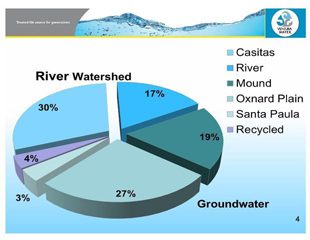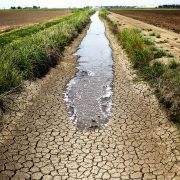Ventura’s Water Crisis Is A Study In Procrastination

“Water, water, everywhere, Nor any drop to drink.” —Samuel Taylor Coleridge The Rime of the Ancient Mariner
THE CHICKENS MAY HAVE COME HOME TO ROOST OVER WATER ISSUES
[A STUDY IN PROCRASTINATION]
We’re in the worst drought in 100 years. The State of California, the City of Ventura and everyone else is concerned about water. Lake Cachuma is almost dry, Santa Barbara decides to finance and build a desalinization plant and Montecito is in such bad shape it asks Ventura to build a pipeline through our City to wheel water from sources to the South.
Alarms were sounded. Nobody thought about water until it was almost gone. The question on everyone’s mind was how the 93,568 citizens in Ventura were going to obtain their drinking water. The City Council held meetings and asked for citizens to reduce water use.

Venturans are concerned over where their drinking water will come from.
On the supply side the Council looks for new sources of water: importing water by tanker, hauling an iceberg off the coast to use melt water, building a pipeline to import the 10,000 acre feet of State water or building a desalinization plant to convert sea water to potable uses.
It was 1992. It was not raining and the community was divided.
The Association for Water Quality Alternatives (AQWA) formed and urged the Council to make a decision – build a reverse osmosis plant to remove dissolved solids and treat brackish water from the Mound ground water basin in the eastern part of the City, or import the 10,000 acre feet of State water by piping it from Lake Pyramid into Lake Piru then to Ventura by pipe line. This group urged state water because the community had, since 1973, invested millions of dollars for the right to import the water, and would continue to pay $1.5 M per year until 2035. Spending $25 M to build a pipeline was the least costly option.
The City Council would not decide. Instead they voted to put a measure on the ballot asking the citizenry to vote on whether we should build a reverse osmosis plant. The vote was 52% in favor of a desalinization (membrane filtration/reverse osmosis) plant and 48% to build the pipeline.
Once the election was over everything stopped. No effort was or has been made to develop, finance AND build an alternative water resource. The Water Department has spent millions since 2008 “studying” and they are “still studying” the options.

Ventura’s Water Crisis Is Nothing New.
Notwithstanding the malaise of local government Mother Nature took control. Between 1992 and 2011 it rained prodigiously. The Ventura County hydrology data for the Casitas dam gauge reflects an average rainfall of 24.10 inches per year in that period. In 1998 it rained 49.68 inches and Casitas dam overflowed. 2005 was another banner year with 42.86 inches followed by 2011 with 30.83 inches. In 2012 rainfall started moving downward – went to 12.01 inches, then 10.72 inches in 2013 and in 2014 it dropped to 8.02 inches.
EDITORS’ COMMENTS:
History has an uncanny way of repeating itself. After 20 plus years of great rainfall could we expect 3 to 5 years of low rainfall in Ventura? The answer is unequivocally yes! This pattern has occurred consistently since we began tracking rainfall in 1880. Human nature is equally predictable – when it is raining why develop and build alternative water resources?
[A WATER EXPERT’S VIEW]

Sources of Ventura’s drinking water
On July 21, 2014, the Ventura City Council appointed a 13 member “Water Supply Strategy Task Force” to hold public meetings and develop a strategy to address potential water shortages in the City of Ventura. This was in response to Governor Brown’s proclamation declaring a statewide water emergency. There have been three meetings, the most recent on September 9, 2014. This public meeting was well attended, and many members of our community spoke, but one in particular deserves mention. With his permission we have printed his letter:
“I bring these comments to the board in an effort to make their job easier. Decisions this group has undertaken to make are decisions that were ALREADY made by the public and city government of the City of Ventura back in November of 1992.
I speak to you based on having been the Production Supervisor of the City of Ventura water dept from 1985 till 1992. Further as the plant operator of the Brackish Water Reclamation Demonstration facility of the Bureau of Reclamation in the City of Port Hueneme from 1997 till 2002. And lastly as the State licenses Water Treatment and Water Distribution instructor for Water Science Dept at Ventura Community College from 1989 til 2013, training and preparing individuals to acquire their State of California licenses to legally work in the water/wastewater industry.
In 1992 the city of Ventura was recovering from a major drought. Part of the dialog going on was that the City should avail itself of State imported water by constructing a pipeline from Ventura to Castaic.
This would have provided the City access to water it would need but as history has shown was and is NOT available. The State imported water system has historically NOT been able to provide the water contracted for, as the system was never finished and is not capable of meeting those contract levels EVEN when water is available and when in a drought that water is NOT available. Further, connection to that water supply would take ANY control of amounts or costs AWAY from local control, i.e. Sacramento declaring water emergencies and applying mandatory cutbacks.
That commitment is what this body should be working to see HAVE HAPPEN. It makes no sense to discuss or study the local water situation thinking or including State mandates when the State plays no part in the City of Ventura’s water supply situation.
It also makes no sense to request the public of this city to further reduce their water usage as the historical records indicate that our citizens have already reduced their consumption of water per capita by more than 50% since the 90’s. Requesting our citizens to further reduce their water use so that water will be available for the ADDITIONAL population that is being allowed with continued grown is NOT a productive avenue.
The productive avenue and manner to address the current water shortage in our City is to build the treatment facilities that were recognized would be REQUIRED nearly two decades ago.
The City owns and has available water sources already in existence that are NOT being used as the water quality did not meet (drinking water) standards WITHOUT treatment. But those existing facilities (expensive ones we already own like Victoria Well 1or any of a least three other wells the city owns but is not using ) can and should be utilized as the raw water source to a membrane treatment plant that could provide better quality water that we are getting now from surface water and at a price significantly cheaper than what State imported water is costing our neighboring cities. Those cost benefits were documented and fully recognized at the Demonstration facility a decade ago.
Membrane treated water from a plant utilizing ground water TOTALLY under the control of the CITY of Ventura makes significantly more sense than asking our citizens to lower the value of their property, accept reductions in use that are set by the state, (which has NOTHING to do with our water supply), is capable of providing HIGHER quality water than we have now, at CHEAPER prices than what our neighbors are paying the state, and follows the directives and sensible decisions made by our citizens and political bodies more than 22 years ago”
—JOSEPH RICHARDSON
Ventura, California
EDITORS’ COMMENTS
Municipal government has declined to make any decision to develop an alternative water supply for the City of Ventura in the last 23 years. Waiting another 20 plus years would be an absurdity. Our current Council can, and must, make a decision. In the words of baseball great Yogi Berra, “When you come to a fork in the road take it.”
Post Script
VREG is closely watching the Water Supply Task Force Committee’s work on how “our” water conservation program will be designed, monitored and implemented in our community. It was not lost on the VREG committee that shortly after the first of a 3-year rate increase in water rates went into effect in July 2014, additional administrative personnel was hired.
Update on County Pension Reform
After months of signature gathering to qualify as a ballot initiative for the County of Ventura, a Ventura County Superior court judge decided that this initiative was not a valid because the County of Ventura cannot elect to withdraw from a system that it first elected to join. That ruling stated that any needed reform for the Ventura County pension plan must come from the state level. It does not seem to be the political will of the State Assembly or State Senate to tackle this ongoing problem.
Future VREG topic- Ventura City Budget
The June 2014 annual General Budget is in and is being reviewed.
Editors:
R. Alviani K. Corse T. Cook
J. Tingstrom R. McCord S. Doll
For more information like this, subscribe to our newsletter, Res Publica. Click here to enter your name and email address.

